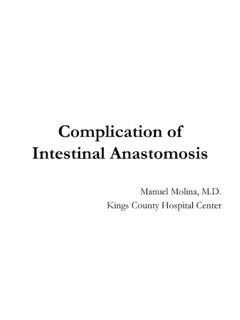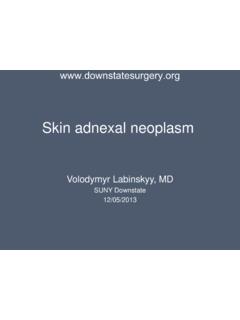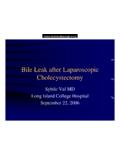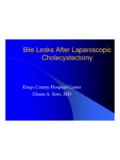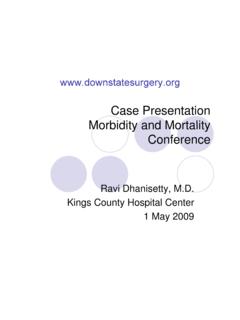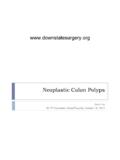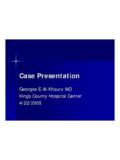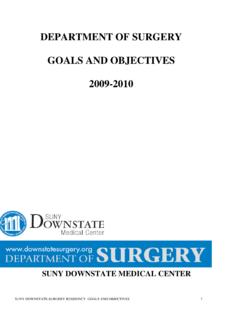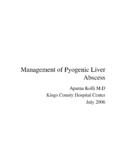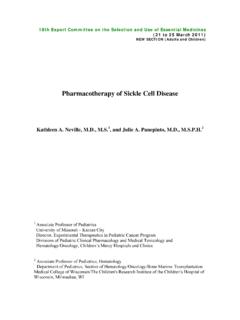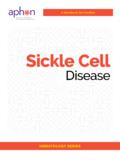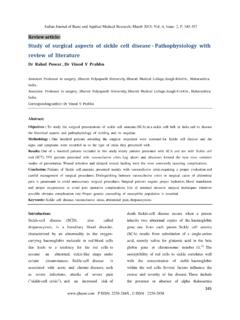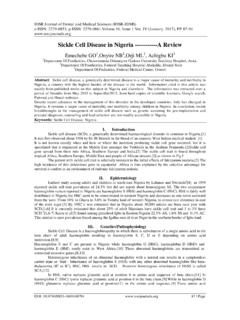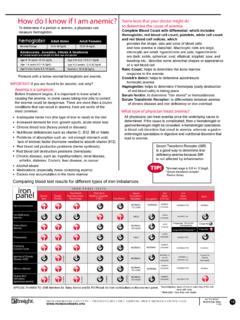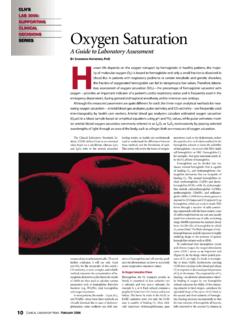Transcription of www.downstatesurgery.org Perioperative Management of ...
1 Perioperative Management of Patients with sickle Cell Disease November 29th, 2012 David Vivas, MD - History CC: RLQ pain HPI: 14 y/o female with h/o Hg SC presented to ED with 4 days h/o abdominal pain, initially diffuse but later locating to RLQ, associated with nausea, vomiting x 4 (nonbilious/nonbloody) and back pain. Patient denied fevers, diarrhea. - History PMH: SCD, multiple hospital admissions for pain crises in Jamaica PSH: None SHx: Patient recently emigrated to the US from Jamaica (2 weeks prior to presentation) FHx: Father, mother, brother with SCD NKDA - PE VS: T , HR: 125, BP: 111/69, RR: 30, SaO2: 99% AAOx3, In mod.
2 Distress Scleral icterus CV: RRR, tachycardic Chest: CTA, b/l Abdomen: Mod. distension, + BS, soft, diffusely TTP. + guarding on RLQ Ext: No edema CBC: > <226 Ret: BMP: 137 <107 LFT: 15/13 Abdominal US Splenomegaly, mild enlargement of the liver, normal appearing gall bladder Patient was admitted to Pediatrics IV fluids IV Abx Pain control Pediatric Surgery Consult: Recommend CT abdomen/pelvis IV/PO contrast CT scan Acute appendicitis, suspected perforation.
3 No discrete abscess Moderate splenomegaly. No splenic lesions Scan Scan Scan Labs CBC: > <162 Ret LFT: 4/27 Hematology Evaluation Pediatric Hematology Consultation: Hb SC patient with unusually difficult course in Jamaica (No ACS reported) with urgent need for laparotomy Concern for some sequestration due to drop in Hb, tender liver and spleen, rising Tbili Hematology Evaluation Pediatric Heme Consultation Recommendations: Exchange would be invasive and delay surgery Transfuse 2 units RBC s over 2-3 hrs Avoid over-hydration Aggressive pulmonary toilet, IS PICU admission Operative Course 2 units of PRBC s were ordered Patient was taken to OR for emergent appendectomy after 1st unit PRBC was being administered Operative Course Open Appendectomy 200 ml pus drained upon entering peritoneal cavity Appendix was necrotic, covered with fibrin.
4 Perforated Wound was left open Post op Course Patient was extubated and transferred to PICU NGT IV Abx (meropenem) Incentive spirometry Pain control Post op Course POD # 1- 6 patient improving Pain well controlled Febrile on POD # 1 Low grade fever on POD # 3 Afebrile after POD # 3 Bowel function returned POD # 2 Diet advanced to regular by POD # 4 Wound was closed on POD # 4 (delayed primary closure) Post op Course POD # 7 patient was transferred to regular pediatric floor POD # 8 10 WBC noted to rise from to POD # 10 surgical wound was opened POD # 11 WBC CT Abd/Pel: x cm abscess in LLQ anterior to psoas muscle Scan Post op Course Patient underwent IR drainage of intra-abdominal collection By POD # 18 patient had finished course of Abx and remained afebrile, tolerating a diet, with a clean surgical wound.
5 WBC remained WNL Patient was D/C home on POD # 19 Management of Patients with sickle Cell Disease Science/Genetics Syndromes Overview clinical manifestations for surgical treatment Considerations Principles Cell Dz: Basic Science hemoglobin is a tetrameric protein consisting of 2 alpha ( ) and 2 nonalpha polypeptide chains ( , , , ) attached to 4 iron-containing heme complexes sickle cell anemia is a genetic disorder caused by an autosomal co-dominant single gene defect in the -globin chain of HbA, which produces HbS HbS is formed by the substitution of glutamic acid (negatively charged) by valine (nonpolar) in position 6 of the -globin chain of hemoglobin has 2 interrelated effects.
6 - The hemoglobin S molecule is unstable and degrades more rapidly - The deoxygenated form is insoluble and precipitates out of solution in the cytosol sickle Cell Dz: Basic Science HbS becomes insoluble at O2 tension in venous range kPa Upon deoxygenation, HbS tends to crystallize and precipitate The precipitation and polymerization of hemoglobin deforms the cell The distortions include the characteristic sickle shape that gives the disease its name sickle Cell Dz: Basic Science Cell Dz.
7 Basic Science The term sickle cell anemia (SCA) refers to HbSS disease SCA occurs if HbS is inherited from both parents (HbSS genotype) sickle Cell Dz: Basic Science Other forms of sickle cell disease may occur if HbS is inherited from one parent and another abnormal hemoglobin , is inherited from the other parent hemoglobin C (HbSC) -thalassemia (HbS -thalassemia) sickle Cell Dz: Basic Science hemoglobin C is a -chain variant, most common in people of West Africa The combination with another mutation (ex HbSC disease) produces symptoms of sickle cell disease The term sickle cell disease (SCD) refers to all of the genotypes (HbSS, HbSC, HbS -thalassemia) sickle Cell Dz: Basic Science SCD is the most common inherited blood disorder in the United States, occurring in 1.
8 2,647 births SCA accounts for 60% to 70% of SCD in the SCD occurs in 1 in every 500 African Americans About 8% of African Americans are carriers SCD In sickle cell trait (SCT), there is inheritance of one Hb S allele (Hb AS) 25% to 30% of neonates in western Africa are carriers of the SCT Approximately 8% of African Americans have SCT Cell Syndromes Overview sickle cell disease is characterized clinically by a shortened life span Median age at death is approximately 42 years for men and 48 years for women Affected patients characteristically are asymptomatic until approximately 4 to 6 months of age Cell Syndromes Overview Disease manifestations are most severe in patients with homozygous Hb SS
9 SCT (Hb AS) is often asymptomatic but sickling can occur at very low oxygen tensions (below 3 kPa) Cell Syndromes Major Clinical Manifestations Anemia Chronic, reasonably well-compensated hemolytic anemia, reticulocytosis Erythrocytes are destroyed randomly, with a mean life span of 17 d (normal: 110 to 120 d) Acute severe anemia: Splenic sequestration crisis Aplastic crisis Hyperhemolytic crisis Cell Syndromes Major Clinical Manifestations Acute painful episodes ( sickle cell crisis)
10 Most common May be precipitated by weather conditions, dehydration, infection, stress, exercise, alcohol consumption, obstructive sleep apnea Up to half of episodes have no identifiable cause Can affect any area of the body, with the back, chest, extremities, and abdomen being most commonly affected Can range from trivial to excruciating Cell Syndromes Major Clinical Manifestations Acute chest syndrome (ACS) Most common form of acute pulmonary disease Second most common cause of hospitalization in SCD and the leading cause of death Defined as the new appearance of an infiltrate with pulmonary symptoms in a patient with SCD Cell Syndromes Major Clinical Manifestations Acute chest syndrome (ACS)

